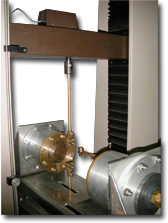Ferromagnetic SMA and related composites
 Modern technologies need transducing materials, which combine large strains, high-force production and fast dynamic response during an actuation event. The functionality of these materials is based on the physical mechanisms responsible for the electric, magnetic or thermal energy transformations into mechanical work, which produce the actuation. The reverse energy conversion is in use for sensing. The efficiency, power density and speed of these types of energy conversion determine the advantages and drawbacks of these materials in the applications.
Modern technologies need transducing materials, which combine large strains, high-force production and fast dynamic response during an actuation event. The functionality of these materials is based on the physical mechanisms responsible for the electric, magnetic or thermal energy transformations into mechanical work, which produce the actuation. The reverse energy conversion is in use for sensing. The efficiency, power density and speed of these types of energy conversion determine the advantages and drawbacks of these materials in the applications.
The best-known actuator materials such as (ferro-)piezoelectric, magnetostrictive, shape memory alloys (SMAs), rheological liquids, etc., do not fully correspond to the aforementioned ideal combination of properties. As an example, a slow response due to thermal inertia is typical of the shape memory materials, while their advantage lies in the very large reversible strains (more than one order of magnitude, compared with other materials in question). The disadvantage of slow response in ordinary SMAs can be overcome by using shape memory materials which are also ferromagnetic.
The latter materials emerged recently as a novel class of multifunctional materials denoted as ferromagnetic shape memory alloys (FSMAs), which combine the properties of ferromagnetism with those of a thermoelastic martensitic transformation. An FSMA material in the form of ribbon is embedded in elastomeric matrices forming a hybrid functional material capable for strain recovery of the order of 5%. The magnetomechanical properties of the hybrid material are defined by means of a mechanical tester integrated with a permanent magnet. The maximum magnetic field of the magnet is 1.9T for a magnet pole separation of 1.5 cm.
Researchers involved:
• Panagiotis Pappas
Relevant Publications:
- "Magnetomechanical Properties of Shape Memeory Alloys" by D. Bourdounis, P. Pappas, D. Kouzoudis, J. Parthenios, C. Galiotis, 3rd Greek Conference on Metallic Materials, December 6-7, 2007, University of Patras Download the paper (pdf in Greek language)
